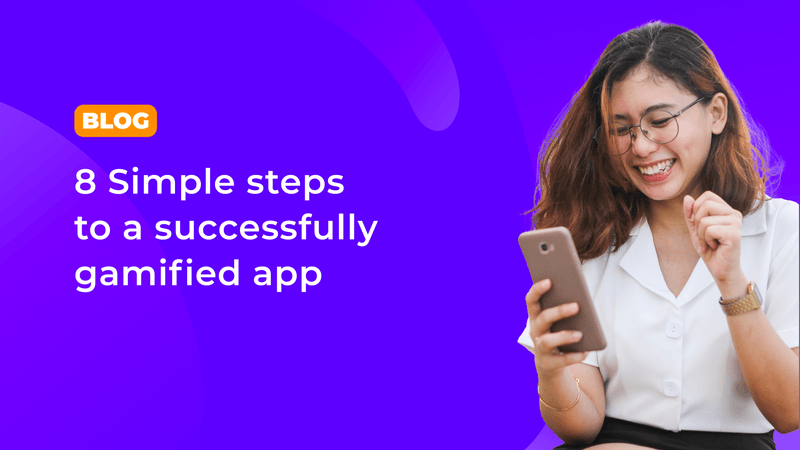Follow these 8 simple steps to create a successful gamified app

It goes without saying that growth teams want to maximize their app retention and user engagement. But how you go about achieving that is what makes your user experience special! To inspire your own app gamification journey, let’s discover how gamification is used in apps & what a gamified experience looks like. Finally, we’ll give you 8 simple steps to build your own gamified app.
- The idea behind app gamification
- What is a gamified experience?
- 3 ways to get users hooked with app gamification (with real-life examples!)
- 8 steps of implementing app gamification
- Top 3 gamified app examples
- FAQ
The idea behind app gamification
Gamification introduces game-like elements like badges, points, and levels to create a more motivating user experience. Far from turning your app into an outright game, app gamification augments your existing UX by incentivizing desired user activity and inspiring a powerful intrinsic motivation.
Simply put, intrinsic motivators are complex concepts like the need for personal growth, purpose, and fun. Altogether, these factors make your app naturally fun and satisfying to use, in turn boosting engagement!
Mauro Cherubini – “The greater the intrinsic motivation, the more likely an individual is to engage in a behavior over the long-term.”
In fact, the benefits of intrinsic motivation are one of the most compelling arguments for why apps should choose to gamify. Research has shown that gamification has a positive effect on intrinsic motivation and this makes it an indispensable tool for those looking to motivate their users and push up their metrics.
What is a gamified experience?
A gamified experience emphasizes personal progression, intersocial competition, and rewards. In short, a goal tailored to the individual, a fun way to achieve it, and rewards to make the journey worthwhile. Consciously or not, every app can fit into this model!
Take health & fitness apps for example, where many users sign up to get fit. Already, that’s the ideal base for a gamified journey! Or look at fintech, where new users open an account to save money or simply to be rewarded. In fact, finance consumers say that rewards are one of the most attractive pull factors when picking a digital bank.
As you can see, with just the most basic motivation you have fertile ground to build a gamified experience that maximizes those emotions.
To put a gamified experience in concrete terms, these 5 mechanics are essential:
- Relationships. People are naturally social. Features like leaderboards or group challenges can put this into motion, and motivate your users.
- Accomplishment. If winning doesn’t feel like winning, then what’s the point? Make sure to celebrate user progress with levels, badges, and points.
- Empowerment. Just as users have their own end goals, the journey to achieve them is also personal. To meet this need, empower users with customization.
- Unpredictability. Keep your UX feeling new and worth coming back to. Challenges, wagers, and hotzones can add much-needed depth to your UX.
- Constraint. Teens might call this FOMO or the ‘fear of missing out’. In short, people are highly motivated to avoid negative outcomes or constraints!
3 ways to get users hooked with app gamification (with real-life examples!)
The greatest strength of a gamified app lies in its power to boost user engagement and retention. When you make the UX fun, users get hooked on your product! And in a world of product-led growth, this has never been more important.
But let’s get to the heart of it, how is gamification used in apps? Primarily, app gamification can be used to achieve 3 goals:
#1 Evoke customer emotion
Right from the beginning, app gamification is designed to elicit positive emotions in the user. For example, users get satisfying and motivating dopamine hits from receiving badge rewards or simple positive reinforcement. Indeed, studies show that gamified rewards increase cognitive user engagement.
#2 Build customer habits
Habit-forming is crucial. To incentivize your users to engage, use gamification features like streaks and challenges. Indeed, regular engagement works wonders: 90% of new users who engage weekly are retained on Day 30, compared to 23% for those who don’t.

#3 Drive repeat engagement
A boost in repeat engagement reaps other rewards in addition to retention. More user engagement means more data, and that data allows you to better personalize and contextualize your UX and marketing offers.
In short, when you look at how gamification is used in other apps, you should look out for how they make every interaction matter! While a gamified app can leverage many tools to meet these aims, knowing why it is done is the first step in implementing gamification yourself.
8 steps of implementing app gamification
Introducing app gamification means making a plan. Without a solid base, you risk creating an inconsistent UX that pushes users away, rather than hooking them in. In fact, if you’re looking to enact your holistic gamification strategy, a great way of doing so is with a flexible and scalable building blocks gamification software.
But before implementing gamification, you need a plan! Luckily for you, you can follow these 8 simple steps designed to be personalized to your unique situation:
- What are your growth goals? Start your journey by imagining its end. After that, list the obstacles blocking your path. This will help frame your plan.
- Explore your app! Make a general assessment of your app’s functionality. What service does it actually offer to users?
- Identify a target audience. Learn not just who your users are and what they like, but find out what motivates them. This is your key to engagement!
- Find the user interactions. Speaking of user engagement, what is your ideal user interaction? Is the route to interaction simple, or complicated?
- Learn from the best (and worst). Study how competitors leverage gamification, from great examples to not-so-great examples.
- Select your strategy. Based on the information you’ve gathered and what goals you want to achieve, now is the time to pave the way forward. This strategy should leave room for growth – in short, ensure it is scalable.
- Develop gamification features. It’s here that your gamified app takes shape! Leverage user data to develop challenges and rewards that will motivate users.
- Evaluate and optimize the gamification features. Test, test, test! Measure your success using key KPIs such as daily/weekly user engagement and other feedback methods. Use this to inform your optimization strategy, which will keep your app fresh and relevant.
Top 3 gamified app examples
Navexa uses free trial rewards to lock in engagement early
How is gamification used in apps to increase user engagement during onboarding? To be sure, this is a serious challenge. In 2019, average app user retention by Day 14 was just 5.8%. In contrast, Navexa boasts a 50% conversion rate from trial to a paid subscription in 14 days. Now that’s a success!
Navexa solved this problem with one clever gamification feature. To reward free trial users with the highest engagement, every step of onboarding that is completed earns users an extra free trial day! In essence, Navexa is incentivizing users to learn the value of the product, as well as giving them double the time to experience that value.

Badges help Fitocracy user hit their fitness goals (as well as help Fitocracy reach their goals)
Is the aim of your users to get fit? Whatever it is, badges can help them get there. Not only that, Fitocracy’s clever use of badge rewards aligns with what they want to see from their users. For instance, badges are given to users who post on the in-app community. This can push users to socialize and become a part of the community, a hugely powerful motivation to be sure. That will keep users engaged, exercising, and reaching their goal!
Indeed, Fitocracy’s badges have been noted by a study as ‘incentivizing continued use to earn them all’. In other words, that means higher engagement and longer retention!

Mobility app Ciclogreen challenges Spain to travel green
Issuing a group challenge is one of the best ways to clearly communicate your brand values. Not only does it entice users to test their ability, but the competition inherent in a group challenge motivates users to be the best. It’s for this reason that Spanish mobility app Ciclogreen ran a public leaderboard on their ‘30 days by bike’ challenge.
In totting up the distance traveled sustainably by employees and university students, Ciclogreen inspired a powerful sense of motivation. Or as a recent study put it:
Gamification through leaderboards, 2019 – “When [users] share the same score in leaderboards, all users appear at the same position, fostering relatedness. They feel they are part of a group and can discuss results with their peers.”
The challenge and its leaderboard worked – Ciclogreen engaged over 44 organizations and nearly 13,300 users! All in all, over 101,000 kilometers were traveled sustainably. And to sweeten the deal, the most active individual users won prizes like backpacks and bike helmets. To be sure, those users won’t forget the challenge anytime soon!


